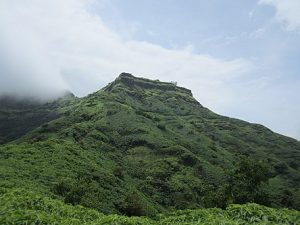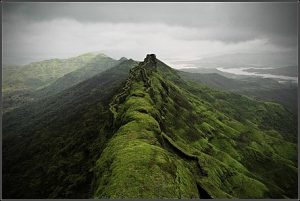Overview:
| Type | Hill Fort |
| Location | 40kms from Pune Railway Station |
| District | Pune |

Rajgad (Ruling Fort) is a hill fort situated in the Pune district of Maharashtra, India. Formerly known as Murumdev, the fort was the capital of the Maratha Empire under the rule of Chhatrapati Shivaji Maharaj for almost 26 years, after which the capital was moved to the Raigad Fort. Treasures discovered from an adjacent fort was used to completely build and fortify the Rajgad Fort.
The Rajgad Fort is located around 60 km (37 mi) to the south-west of Pune and about 15 km (9.3 mi) west of Nasrapur in the Sahyadris range. The fort lies 1,400 m (4,600 ft) above the sea level. The diameter of the base of the fort was about 40 km (25 mi) which made it difficult to lay siege on it, which added to its strategic value. The fort’s ruins consist of palaces, water cisterns, and caves. This fort was built on a hill called Murumbadevi Dongar (Mountain of the Goddess Murumba). Rajgad boasts of the highest number of days stayed by Chhatrapati Shivaji Maharaj on any fort.
History:
The fort has stood witness to many significant historic events including the birth of Chhatrapati Shivaji’s son “Rajaram Chhatrapati”, the death of Shivaji’s Queen Saibai, the return of Shivaji from Agra, the burial of Afzal Khan’s head in the Mahadarwaja walls of Balle Killa, the strict words of Sonopant Dabir to Shivaji.
The Rajgad Fort was also one of the 17 forts that Chhatrapati Shivaji Maharaj kept when he signed the Treaty of Purandar in 1665, with the Mughal general Jai Singh I, leader of the Mughal forces. Under this treaty, 23 forts were handed over to the Mughals.
There are different ways to enter Rajgad Fort:
Padmavati Machee:
This is the most popular route and starts from Gunjavane village. This route takes approximately 2 and a half hours to ascend the fort and leads to the Padmavati Machee (Plateau). However, one needs to navigate a treacherous and steep rocky incline to reach Chor Darwaza. To reach Gunjavane, drive towards Satara on the Pune Bangalore NH4 Highway. After about 30kms from Warje Naka in Pune, turn right at Nasrapur. From here, Gunjavane is 28 kilometres. Follow road directions to Rajgad. These directions are only available in Marathi. However, asking the locals on the street will be a great help.
Via Pali Darwaza:
This is a simple climb. However, it will take longer to climb from here as compared to Chor Darwaza. To get here, turn right from Nasrapur and go to Velhe village. From there, walk to Pabe village and ask the locals for directions to climb the fort. It should take approximately 3 hours to climb via this route.
Suvela Machee via Chor Darwaza:
From Gunjavane village, there is a route through the forest which leads to Suvela Machee. However, it’s a treacherous path comprising steep rock faces. It’s advisable to climb from this path only under expert guidance and with professional mountain climbing equipment.
Places to visit on the Fort:
Padmavati Lake: There is a small fresh water lake on Padmavati Machee. The chor darwaza leads to here directly. The walls of the lake are intact even today and the lake never dries up (even in the hottest summer). Once you climb the fort, it would be a good idea to remove your shoes and relax a little by dangling your feet in the water. There are small fish in the lake and they come to nibble at the dead skin on your feet
Padmavati Temple: This temple was constructed by Shivaji Maharaj himself. In front of the temple is the tomb of Saibai, Shivaji Maharaj’s wife.
Rameshwar Temple: This is located in front of Padmavati temple. The Shiva linga present is believed to be of Shivaji Maharaj’s times.
Padmavati Machee: There are 3 machees on Rajgad. One of the best maintained is the Padmavati Machee. This was a military base as well as a residential area.

Sanjivani Machee: This extends approximately for 2 and a half kms and has been constructed in three phases. For each phase, an armoured fortified place is provided. There are many cisterns on this machee. There is also an underground escape route (unusable now) which leads directly to the outermost fortification.
Suvela Machee: This is situated on the eastern part of the fort. This machee narrows down in width as one proceeds farther along its length. At the start of the machee, there is a hill called ‘Duba’. As we proceed ahead, there is a small temple of Lord Hanuman. Straight ahead from this temple leads to the second stage, from where the fortification starts. If you turn right before the steps leading to the fortification and walk a little, you will come across a giant hole in the rock face. This is about 3 metres in diameter and has been carved by the force of wind. This hole is called ‘Nedh’ or ‘Hatti Prastar’. It’s possible to climb into this hole for a good view. At the base of this hole is an idol of Lord Ganesha and one can reach a second Gupt Darwaza from here. This doorway is called ‘Madhe darwaza’.
Alu Darwaza: This is one of the entrances to the fort. If one walks from Torna fort to Rajgad, then this is the only way to enter.
How to reach:
Rajgad is 40 Km from Pune.The Way to rajgad is via Nasraour Phata which is about 15-20Kms from Katraj Tunnel. From base village you can reach through 3 routes. From Gunjawane, Pali and from Bhor route,
Related Video (Rajgad Fort):
Best time to visit :
The best season to visit Rajgad is during the monsoons and the winter season i.e. from July to February . Trekking feels fantastic during the monsoons but trekkers should take precautions as the route gets very slippery. Winter season is ideal for camping on the fort.
